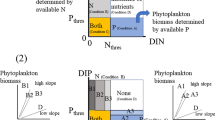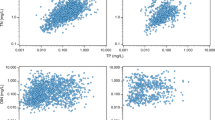Abstract
Nutrient concentrations and other environmental factors were measured in the Daechung Reservoir for 25 weeks from spring until autumn in 1999. The high irradiance after heavy rainfall provided optimal meteorological conditions for bloom formation during summer, therefore, rain would also appear to forecast imminent bloom. The bloom formation was largely governed by cyanobacteria, in particular, Microcystis spp. and Anabaenaspp. Phycocyanin showed higher correlation with cyanobacteria (r = 0.744, P < 0.001) compared to chlorophyll-a(r = 0.599, P < 0.01). Therefore, phycocyanin was more accurate and useful than chlorophyll-a in quantitatively measuring cyanobacterial blooms. The atomic N:P ratio of the particulate form also showed a high correlation with cyanobacteria (r = 0.541, P < 0.01), increasing from 4.3 to 14.6 during bloom formation, while that of the dissolved form decreased from 25.5 to 8.7. These results indicated that the algae assimilated N significantly without comparable P uptake during the blooming season, which was in sharp contrast to the excessive storage of P during the spring.
Similar content being viewed by others
References
An, K.-G. & J. R. Jones, 2000. Factors regulating bluegreen dominance in a reservoir directly influenced by the Asian monsoon. Hydrobiologia 432: 37-48.
APHA, 1995. Standard Methods for the Examination of Water and Wastewater, 19th edn. American Public Health Association, Washington, DC.
Behrenfeld, M. J. & Z. S. Kolber, 1999. Widespread iron limitation of phytoplankton in the South Pacific Ocean. Science 283: 840-843.
D'Elia, C. F., P. A. Steudler & N. Corwin, 1977. Determination of total nitrogen in aqueous samples using persulfate digestion. Limnol. Oceanogr. 22: 760-764.
Elrifi, I. R. & D. H. Turpin, 1985. Steady-state luxury consumption and the concept of optimum nutrient ratios: a study with phosphate and nitrate limited Selenastrum minutum (Chlorophyta). J. Phycol. 21: 592-602.
Falconer, I. R., 1994. Health problems from exposure to cyanobacteria and proposed safety guidelines for drinking and recreational water. In Codd, G. A., T. M. Jefferies, C. W. Keevil & E. Potter (eds), Detection Methods for Cyanobacterial Toxins. The Royal Society of Chemistry, Cambridge: 3-10.
Glibert, P. M. & D. E. Terlizzi, 1999. Co-occurrence of elevated urea levels and dinoflagellate blooms in temperate estuarine aquaculture ponds. Appl. envir. Microbiol. 65: 5594-5596.
Lampert, W. & U. Sommer, 1997. Limnoecology: The Ecology of Lakes and Streams. Oxford University Press, New York: 382 pp.
Mason, C. F., 1991. Biology of Freshwater Pollution, 2nd edn. Longman Scientific and Technical, Essex: 351 pp.
McQueen, D. J. & D. R. S. Lean, 1987. Influence of water temperature and nitrogen-phosphorus ratios on the dominant bluegreen algae in Lake St. George, Ontario. Can. J. Fish. aquat. Sci. 44: 598-604.
Menzel, D. W. & N. Corwin, 1965. The measurement of total phosphorus in seawater based on the liberation of organically bound fractions by persulfate oxidation. Limnol. Oceanogr. 10: 280-282.
Myers, J., J. R. Graham & R. T. Wang, 1978. On spectral control of pigmentation in Anacystis nidulans (Cyanophyceae). J. Phycol. 14: 513-518.
Oh, H.-M. & D.-H. Kim, 1995. Short-term prediction of the bluegreen algal bloom in Daechung Reservoir. Korean J. Limnol. 28: 127-135.
Oh, H.-M. & G-Y. Rhee, 1991. A comparative study of microalgae isolated from flooded rice paddies: light-limited growth, C fixation, growth efficiency and relative N and P requirement. J. appl. Phycol. 3: 211-220.
Oh, H.-M., J. Maeng & G-Y. Rhee, 1991. Nitrogen and carbon fixation by Anabaena sp. isolated from a rice paddy and grown under P and light limitations. J. appl. Phycol. 3: 335-343.
Parker, D. L., H. D. Kumar, L. C. Rai & J. B. Singh, 1997. Potassium salts inhibit growth of the cyanobacteria Microcystis spp. in pond water and defined media: implications for control of microcystin-producing aquatic blooms. Appl. envir. Microbiol. 63: 2324-2329.
Reynolds, C. S., 1987. Cyanobacterial water-blooms. Adv. Bot. Res. 13: 67-143.
Reynolds, C. S., 1998. What factors influence the species composition of phytoplankton in lakes of different trophic status? Hydrobiologia 369/370: 11-26.
Reynolds, C. S. & A. E. Walsby, 1975.Water blooms. Biol. Rev. 50: 437-481.
Reynolds, C. S., M. Dokulil & J. Padisák, 2000. Understanding the assembly of phytoplankton in relation to the trophic spectrum: where are we now? Hydrobiologia 424: 147-152.
Rhee, G-Y. & I. J. Gotham, 1980. Optimum N:P ratios and coexistence of planktonic algae. J. Phycol. 16: 486-489.
Rhee, G-Y. & I. J. Gotham, 1981. The effect of environmental factors on phytoplankton growth: temperature and the interactions of temperature with nutrient limitation. Limnol. Oceanogr. 26: 635-648.
Schindler, D.W., 1977. Evolution of phosphorus limitation in lakes. Science 195: 260-262.
Terry, K. L., E. A. Laws & D. J. Burns, 1985. Growth rate variation in the N:P requirement ratio of phytoplankton. J. Phycol. 21: 323-329.
Tilman, D., S. S. Kilham & P. Kilham, 1982. Phytoplankton community ecology: the role of limiting nutrients. Ann. Rev. Ecol. Syst. 13: 349-372.
Tilman, D., M. Mattson & S. Langer, 1981. Competition and nutrient kinetics along a temperature gradient: an experimental test of a mechanistic approach to niche theory. Limnol. Oceanogr. 26: 1020-1033.
Watson, S. B., E. McCauley & J. A. Downing, 1997. Patterns in phytoplankton taxonomic composition across temperate lakes of differing nutrient status. Limnol. Oceanogr. 42: 487-495.
Welch, E. B. & T. Lindell, 1992. Ecological Effects of Wastewater: Applied Limnology and Pollutant Effects. Chapman & Hall, London: 425 pp.
Wood, L.W., 1985. Chloroform-methanol extraction of chlorophylla. Can. J. Fish. aquat. Sci. 42: 38-43.
Wynne, D. & G-Y. Rhee, 1986. Effects of light intensity and quality on the relative N and P requirement (the optimum N:P ratio) of marine planktonic algae. J. Plankton Res. 8: 91-103.
Author information
Authors and Affiliations
Corresponding author
Rights and permissions
About this article
Cite this article
Ahn, CY., Chung, AS. & Oh, HM. Rainfall, phycocyanin, and N:P ratios related to cyanobacterial blooms in a Korean large reservoir. Hydrobiologia 474, 117–124 (2002). https://doi.org/10.1023/A:1016573225220
Issue Date:
DOI: https://doi.org/10.1023/A:1016573225220




